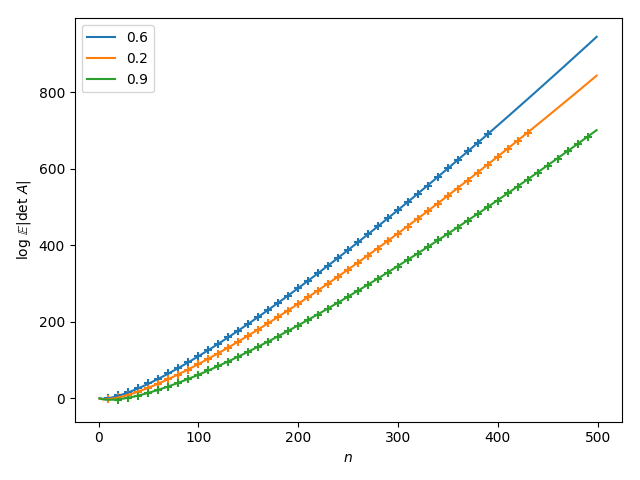Here is a solution to Hipstpaka's question about $\det(A)^2$. I don't
have enough space to answer in a comment. I don't know where a
statement appears in the literature, but the proof uses a standard
technique discussed for instance in Enumerative Combinatorics,
vol. 2, Exercise 5.64.
Write $\varepsilon_w$ for the sign of the permutation $w\in S_n$.
Then
\begin{eqnarray*} \sum_A \det(A)^2 & = &
\sum_{i,j=1}^n\sum_{a_{ij}=0,1} \left(\sum_{w\in S_n}
\varepsilon_w a_{1,w(1)}\cdots a_{n,w(n)}\right)^2\\ & = &
\sum_{i,j=1}^n\sum_{a_{ij}=0,1} \sum_{u,v\in S_n}
\varepsilon_u\varepsilon_v a_{1,u(1)}\cdots a_{n,u(n)}
a_{1,v(1)}\cdots a_{n,v(n)}. \end{eqnarray*}
Let $f(u,v)$ be the number of distinct variables occurring among
$a_{1,u(1)},\dots, a_{n,u(n)},a_{1,v(1)},\dots, a_{n,v(n)}$. The
product $a_{1,u(1)}\cdots a_{n,u(n)}a_{1,v(1)}\cdots a_{n,v(n)}$ is 1
with probability $p^{f(u,v)}$ and is otherwise 0. Moreover, $f(u,v)=
2n-\mathrm{fix}(uv^{-1})$, where $\mathrm{fix}(uv^{-1})$ denotes the
number of fixed points of $uv^{-1}$. If $E$ denotes expectation, then
we get
$$ E(\det(A)^2) = \sum_{u,v\in S_n}\varepsilon_u\varepsilon_v
p^{2n-\mathrm{fix}(uv^{-1})}. $$
Setting $w=uv^{-1}$ and noting that
$\varepsilon_u\varepsilon_{wu^{-1}} = \varepsilon_w$, we get
\begin{eqnarray*} E(\det(A)^2) & = & \sum_{w\in S_n}
p^{2n-\mathrm{fix(w)}}
\sum_u\varepsilon_u\varepsilon_{wu^{-1}}\\ & = &
n!p^{2n}\sum_{w\in S_n}p^{-\mathrm{fix(w)}}\varepsilon_w.
\end{eqnarray*}
Let $g(n)=\sum_{w\in S_n}p^{-\mathrm{fix(w)}}\varepsilon_w$. By
standard generating function techniques (Enumerative Combinatorics,
vol. 2, Section 5.2) we have
\begin{eqnarray*} \sum_{n\geq 0} g(n)\frac{x^n}{n!} & = &
\exp\left( \frac 1p x-\frac{x^2}{2}+\frac{x^3}{3}
-\frac{x^4}{4}+\cdots\right)\\ & = &
(1+x)\exp \left( \frac 1p-1\right)x. \end{eqnarray*}
It is now routine to extract the coefficient of $x^n$ and then compute
$$ E(\det(A)^2)= n!\,p^n(p-1)^{n-1}(1+(n-1)p). $$
In general we don't have $E(\det(A)^2)=E(|\det(A)|)^2$, so this does not directly answer the original question.
For a related question (and answer) see Expected determinant of a random NxN matrix.

 $p$." />
$p$." />